Implications of bipolar voltage mapping and magnetic resonance imaging resolution in biventricular scar characterization after myocardial infarction
- PMID: 30239689
- PMCID: PMC6321957
- DOI: 10.1093/europace/euy192
Implications of bipolar voltage mapping and magnetic resonance imaging resolution in biventricular scar characterization after myocardial infarction
Abstract
Aims: We aimed to study the differences in biventricular scar characterization using bipolar voltage mapping compared with state-of-the-art in vivo delayed gadolinium-enhanced cardiac magnetic resonance (LGE-CMR) imaging and ex vivo T1 mapping.
Methods and results: Ten pigs with established myocardial infarction (MI) underwent in vivo scar characterization using LGE-CMR imaging and high-density voltage mapping of both ventricles using a 3.5-mm tip catheter. Ex vivo post-contrast T1 mapping provided a high-resolution reference. Voltage maps were registered onto the left and right ventricular (LV and RV) endocardium, and epicardium of CMR-based geometries to compare voltage-derived scars with surface-projected 3D scars. Voltage-derived scar tissue of the LV endocardium and the epicardium resembled surface projections of 3D in vivo and ex vivo CMR-derived scars using 1-mm of surface projection distance. The thinner wall of the RV was especially sensitive to lower resolution in vivo LGE-CMR images, in which differences between normalized low bipolar voltage areas and CMR-derived scar areas did not decrease below a median of 8.84% [interquartile range (IQR) (3.58, 12.70%)]. Overall, voltage-derived scars and surface scar projections from in vivo LGE-CMR sequences showed larger normalized scar areas than high-resolution ex vivo images [12.87% (4.59, 27.15%), 18.51% (11.25, 24.61%), and 9.30% (3.84, 19.59%), respectively], despite having used optimized surface projection distances. Importantly, 43.02% (36.54, 48.72%) of voltage-derived scar areas from the LV endocardium were classified as non-enhanced healthy myocardium using ex vivo CMR imaging.
Conclusion: In vivo LGE-CMR sequences and high-density voltage mapping using a conventional linear catheter fail to provide accurate characterization of post-MI scar, limiting the specificity of voltage-based strategies and imaging-guided procedures.
Figures
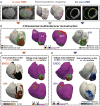
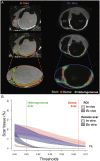
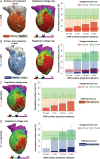
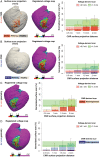
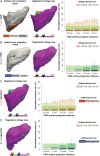
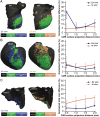
Similar articles
-
Local Conduction Velocity in the Presence of Late Gadolinium Enhancement and Myocardial Wall Thinning: A Cardiac Magnetic Resonance Study in a Swine Model of Healed Left Ventricular Infarction.Circ Arrhythm Electrophysiol. 2019 May;12(5):e007175. doi: 10.1161/CIRCEP.119.007175. Circ Arrhythm Electrophysiol. 2019. PMID: 31006313 Free PMC article.
-
Discordance in Scar Detection Between Electroanatomical Mapping and Cardiac MRI in an Infarct Swine Model.JACC Clin Electrophysiol. 2020 Oct 26;6(11):1452-1464. doi: 10.1016/j.jacep.2020.08.033. JACC Clin Electrophysiol. 2020. PMID: 33121675
-
Whole-Heart Histological and Electroanatomic Assessment of Postinfarction Cardiac Magnetic Resonance Imaging Scar and Conducting Channels.Circ Arrhythm Electrophysiol. 2024 Sep;17(9):e012922. doi: 10.1161/CIRCEP.124.012922. Epub 2024 Aug 28. Circ Arrhythm Electrophysiol. 2024. PMID: 39193754
-
Tissue characterization of the myocardium: state of the art characterization by magnetic resonance and computed tomography imaging.Radiol Clin North Am. 2015 Mar;53(2):413-23. doi: 10.1016/j.rcl.2014.11.005. Epub 2014 Dec 18. Radiol Clin North Am. 2015. PMID: 25727003 Free PMC article. Review.
-
Applications of cardiac magnetic resonance in electrophysiology.Circ Arrhythm Electrophysiol. 2009 Feb;2(1):63-71. doi: 10.1161/CIRCEP.108.811562. Circ Arrhythm Electrophysiol. 2009. PMID: 19808444 Free PMC article. Review.
Cited by
-
Ventricular anatomical complexity and sex differences impact predictions from electrophysiological computational models.PLoS One. 2023 Feb 13;18(2):e0263639. doi: 10.1371/journal.pone.0263639. eCollection 2023. PLoS One. 2023. PMID: 36780442 Free PMC article.
-
Scar shape analysis and simulated electrical instabilities in a non-ischemic dilated cardiomyopathy patient cohort.PLoS Comput Biol. 2019 Oct 28;15(10):e1007421. doi: 10.1371/journal.pcbi.1007421. eCollection 2019 Oct. PLoS Comput Biol. 2019. PMID: 31658247 Free PMC article.
-
Time-efficient three-dimensional transmural scar assessment provides relevant substrate characterization for ventricular tachycardia features and long-term recurrences in ischemic cardiomyopathy.Sci Rep. 2021 Sep 28;11(1):18722. doi: 10.1038/s41598-021-97399-w. Sci Rep. 2021. PMID: 34580343 Free PMC article.
-
Novel systematic processing of cardiac magnetic resonance imaging identifies target regions associated with infarct-related ventricular tachycardia.Europace. 2024 Oct 3;26(10):euae244. doi: 10.1093/europace/euae244. Europace. 2024. PMID: 39298664 Free PMC article.
-
Study protocol: MyoFit46-the cardiac sub-study of the MRC National Survey of Health and Development.BMC Cardiovasc Disord. 2022 Apr 1;22(1):140. doi: 10.1186/s12872-022-02582-0. BMC Cardiovasc Disord. 2022. PMID: 35365075 Free PMC article.
References
-
- Andreu D, Penela D, Acosta J, Fernandez-Armenta J, Perea RJ, Soto-Iglesias D. et al. Cardiac magnetic resonance-aided scar dechanneling: influence on acute and long-term outcomes. Heart Rhythm 2017;14:1121.. - PubMed
-
- Nuhrich JM, Kaiser L, Akbulak RO, Schaffer BN, Eickholt C, Schwarzl M. et al. Substrate characterization and catheter ablation in patients with scar-related ventricular tachycardia using ultra high-density 3-D mapping. J Cardiovasc Electrophysiol 2017;28:1058–67. - PubMed
-
- Amado LC, Gerber BL, Gupta SN, Rettmann DW, Szarf G, Schock R. et al. Accurate and objective infarct sizing by contrast-enhanced magnetic resonance imaging in a canine myocardial infarction model. J Am Coll Cardiol 2004;44:2383–9. - PubMed
-
- Santangeli P, Marchlinski FE.. Substrate mapping for unstable ventricular tachycardia. Heart Rhythm 2016;13:569–83. - PubMed
Publication types
MeSH terms
Substances
Grants and funding
LinkOut - more resources
Full Text Sources
Other Literature Sources
Medical

